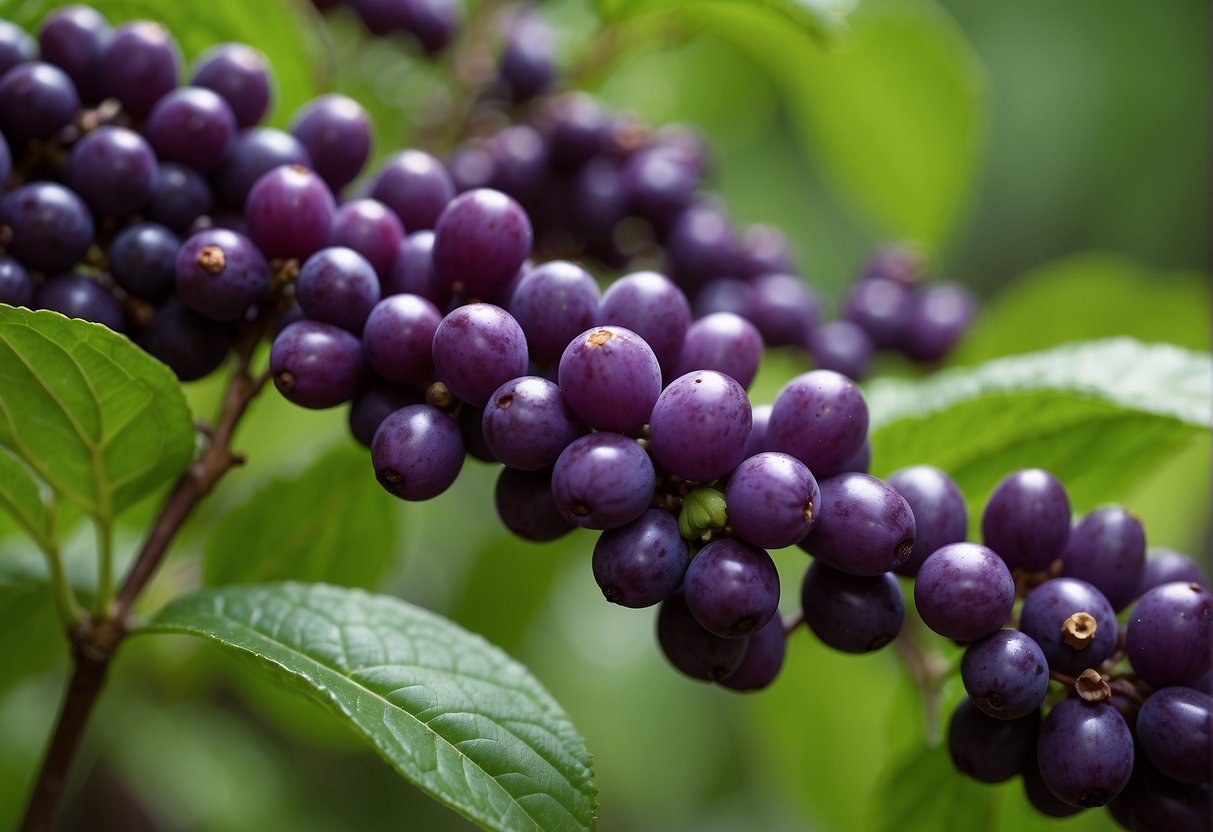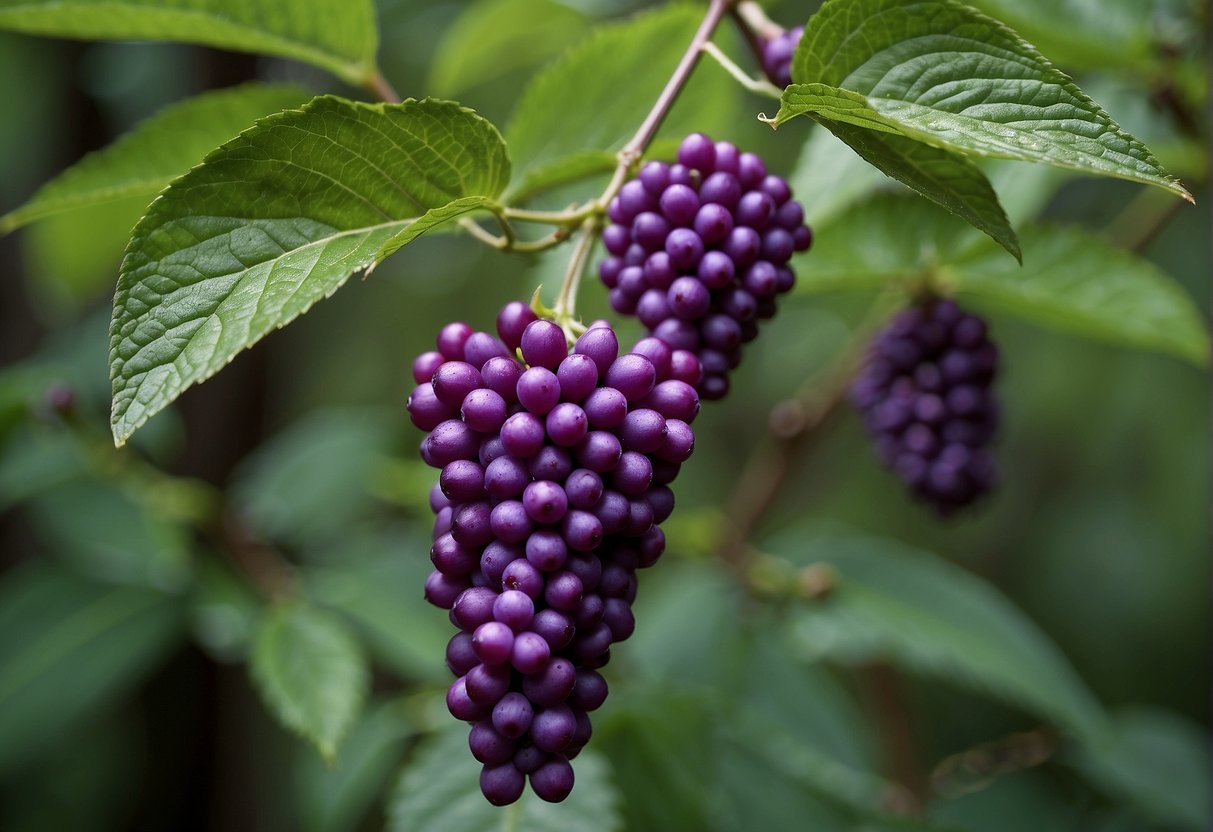For those with a passion for gardening or an interest in indigenous flora, the beautyberry might be a familiar sight. This eye-catching bush is celebrated for its vivid purple berries that embellish its limbs come autumn. However, are you aware that the beautyberry genus encompasses several species, including one indigenous to North America? This piece delves into the American beautyberry, Callicarpa americana, shedding light on its botanical characteristics, natural environment, cultivation practices, and applications.

Callicarpa americana, also known as American beautyberry, is a deciduous shrub that grows in the southeastern United States. It can reach heights of up to six feet and has long, arching branches that are covered in bright green leaves. In the late summer and early fall, the shrub produces clusters of small, pale pink flowers that give way to the plant’s signature bright purple berries. These berries are a favorite food source for birds and other wildlife, and they can also be used to make jelly or other culinary treats.
If you’re interested in adding a native plant to your garden or landscape, or if you’re simply curious about the beautyberry, read on to learn more about this fascinating plant and its many uses.
Key Takeaways
- Callicarpa americana, or American beautyberry, is a native shrub that grows in the southeastern United States.
- The plant produces clusters of bright purple berries in the fall, which are a favorite food source for wildlife and can also be used in culinary applications.
- American beautyberry is a popular choice for native landscaping and can be grown in a variety of habitats, from full sun to partial shade.
Botanical Profile and Habitat

Species Overview
Beautyberry, scientifically known as Callicarpa americana, is a native shrub to North America belonging to the Lamiaceae family. This deciduous shrub is known for its showy purple berries that grow in clusters along the stems. The shrub can grow up to 6 feet tall and 6 feet wide, making it a popular choice for landscaping and wildlife gardens.
Native Range and Habitat
Beautyberry is native to the southeastern United States, where it can be found in forests, woodlands, and along the edges of fields. The shrub prefers full sun to partial shade and can tolerate a wide range of soil types. It blooms in the summer, producing small pink flowers that attract pollinators such as bees and butterflies.
The green leaves of the beautyberry shrub turn yellow in the fall before dropping, revealing the clusters of purple berries that persist into the winter. Some varieties of the beautyberry shrub also produce white berries, which are less common but equally striking.
Beautyberry is an important plant for wildlife, as the berries are a food source for birds and small mammals. Additionally, the shrub is a popular choice for native plant gardens due to its hardiness and attractive appearance.
Cultivation and Uses

Gardening and Landscape
Beautyberry is a popular choice for gardens and landscapes due to its stunning purple berries that appear in the fall. It is a deciduous shrub that can grow up to 6 feet in height and is commonly used as a cover plant due to its dense foliage. Beautyberry prefers moist but well-drained soil and can tolerate both sun and shade. It is best planted in the spring and can be pruned in the winter to encourage new growth. It is also known for its fall color and winter interest, making it a great addition to mass plantings.
Wildlife and Ecological Benefits
Beautyberry is a great source of food for wildlife, including birds, butterflies, and small mammals. It is also a host plant for insects, such as bees and butterflies. Beautyberry is often planted in naturalized areas and wildlife gardens to provide a food source and habitat for these animals. Additionally, beautyberry has been found to have some medicinal properties and is used in traditional medicine for its anti-inflammatory and antimicrobial effects.
Propagation and Maintenance
Beautyberry can be propagated through seeds or softwood cuttings. Seeds should be planted in the fall and require a cold stratification period. Softwood cuttings can be taken in the summer and should be planted in a moist, well-drained soil. Beautyberry requires minimal maintenance and pruning should only be done to shape the plant or remove dead wood. It is tolerant of both moist and dry soil conditions but may require additional watering during periods of drought.
Frequently Asked Questions
What regions constitute the native range of the American beautyberry?
The American beautyberry (Callicarpa americana) is native to the southeastern United States, ranging from Maryland to Florida and west to Texas and Oklahoma.
How can one differentiate between American beautyberry and Chinese beautyberry?
American beautyberry can be distinguished from Chinese beautyberry (Callicarpa bodinieri) by the arrangement of the leaves and the shape of the fruit clusters. American beautyberry has leaves that are arranged in pairs along the stem, while Chinese beautyberry has leaves that are arranged in groups of three. Additionally, American beautyberry has fruit clusters that are more elongated and less compact than those of Chinese beautyberry.
What are the primary uses of American beautyberry?
The berries of the American beautyberry plant have historically been used by Native Americans for medicinal purposes, including as a treatment for colic and fever. Additionally, the berries can be used to make jellies and other culinary creations. American beautyberry is also used as an ornamental plant in landscaping due to its striking purple berries.
Are the berries of the American beautyberry plant safe to consume?
While the berries of the American beautyberry plant are not toxic, they are not typically consumed due to their astringent taste. Some people may also experience stomach upset after consuming the berries.
What are common issues associated with growing American beautyberry?
American beautyberry is generally a low-maintenance plant, but it may be susceptible to fungal diseases in humid environments. Additionally, the plant may be damaged by deer and other wildlife.
What is the scientific name of the American beautyberry?
The scientific name of the American beautyberry is Callicarpa americana.














